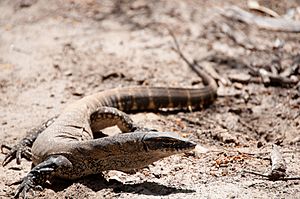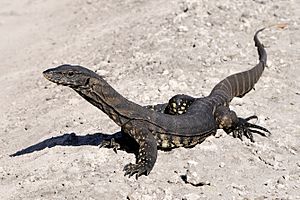Rosenberg's monitor facts for kids
Quick facts for kids Rosenberg's monitor |
|
|---|---|
 |
|
| Conservation status | |
| Scientific classification | |
| Genus: |
Varanus
|
| Species: |
rosenbergi
|
The Rosenberg's monitor (Varanus rosenbergi) is a type of goanna found in southern Australia. These large, fast lizards can grow up to 1.5 metres long, including their tail. They are skilled hunters that eat smaller animals they catch. You can find them in places like the Australian Capital Territory, New South Wales, South Australia, Victoria, and especially in Western Australia.
Contents
About the Rosenberg's Monitor Name
A German scientist named Robert Mertens first described this goanna in 1957. He named it rosenbergi to honor another German naturalist, Hermann von Rosenberg.
For a while, it was thought to be a type of sand goanna (Varanus gouldii). But in 1980, scientists decided it was its own unique species. People also call it the heath monitor or southern heath monitor.
What Rosenberg's Monitors Look Like
Like most monitor lizards, these goannas are quick predators. They have long tails, strong legs, and feet with claws. They look a lot like the sand goanna, but they are usually darker.
You can spot them by the dark marks on their tail tip and belly. They also have clear black bands on their back and neck. Their tails often have dull yellow stripes mixed with black.
Their feet and legs are very dark with creamy or brownish spots. Their dark heads have yellow dots above their mouths. The underside of their body is yellowish-cream with a black net-like pattern.
The biggest Rosenberg's monitors live on Kangaroo Island in South Australia. These island goannas are even darker than those on the mainland. Young goannas have an orange tint.
How Rosenberg's Monitors Behave
These goannas are very active meat-eaters. They can chase and catch large prey. They also eat whatever they can find, like birds, other reptiles, small mammals, eggs, and dead animals.
On Kangaroo Island, scientists found that about one-third of their diet is insects. They also eat many mammals and reptiles. Sometimes, they eat frogs and a few birds. They often find insects by digging through soft soil.
Rosenberg's monitors have been seen eating animals killed on roads, like possums and wallabies. They might also hunt native rats. They get water from the food they eat, especially when it's dry. If there's standing water, they will drink it.
They can get rid of extra salt from their bodies through special glands near their nostrils. This helps them live in salty areas.
Staying Warm and Cool
The Rosenberg's monitor has darker skin, which helps it stay warm in cooler southern climates. They often lie in the sun to warm up. If the ground is warm, they might lie there. They can also climb onto branches to avoid losing too much heat. During the coldest parts of the year, they mostly stay in their burrows.
Female goannas can stay active at night. They keep their body temperature much warmer than the air around them. During cooler seasons, they save energy by going into a sleepy state called torpor. But they can wake up if they need to. If they feel threatened, they will climb a tree to escape.
Where Rosenberg's Monitors Live
These goannas live in the southern parts of Australia. You can find them in Western Australia, South Australia, New South Wales, Victoria, and the Australian Capital Territory. They are most common in Western Australia.
They live in places close to the sea and up to 1500 metres high. In New South Wales, some groups live in high, mountainous areas where it even snows. These groups might be a different species.
Rosenberg's monitors often live in sandy heathland, open woodlands, or sclerophyll forests. They can also be found in other types of plant areas. They dig burrows for shelter. They might also use cracks in rocks or hollow trees.
Rosenberg's Monitor Life Cycle
Rosenberg's monitors use termite mounds to lay their eggs. This is very important for their babies to survive. The termite mound keeps the eggs warm and humid, which helps them grow. Many other monitor species also use termite mounds as nest sites. The mounds keep a steady temperature, usually around 30° Celsius, and never drop below 20° Celsius.
Mating happens in January. In February and March, the female goanna digs into an active termite mound. She makes a round nest chamber deep inside, collapsing the tunnels. This can take her several days. She lays up to 14 eggs. Then, she covers the entrance with the dirt she dug out. The termites then rebuild their mound over the entrance.
The eggs hatch after about seven months. On Kangaroo Island, it can take even longer. This long incubation time might be because of the cooler climate. The baby goannas come out of the mound in September and October. They might get help from the adult goanna to dig out. The babies come out when the weather gets warmer. They bask in the sun and go back into the nest at night if it's cold.
Images for kids











